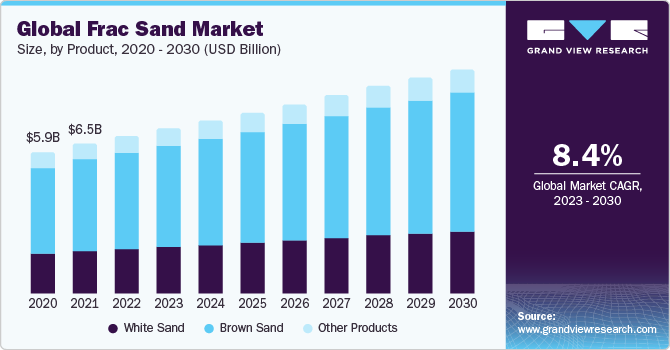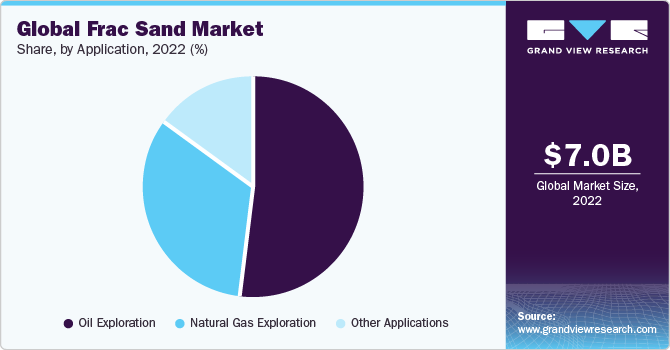- Home
- »
- Advanced Interior Materials
- »
-
Frac Sand Market Size, Share And Trends Report, 2030GVR Report cover
![Frac Sand Market Size, Share & Trends Report]()
Frac Sand Market Size, Share & Trends Analysis Report By Product (White Sand, Brown Sand), By Application (Oil Exploration, Natural Gas Exploration), By Region, And Segment Forecasts, 2023 To 2030
- Report ID: GVR455967
- Number of Report Pages: 100
- Format: PDF, Horizon Databook
- Historical Data: ---
- Forecast Period: 1 - 2030
- Industry: Advanced Materials
Frac Sand Market Size & Trends
The global frac sand market was valued at USD 7.04 billion in 2022 and is expected to grow at a CAGR of 8.4% over the forecast period. The primary driver of frac sand demand has been the expansion of shale oil and gas production. Hydraulic fracturing, or fracking, is a technique used to extract hydrocarbons from tight shale formations. It involves injecting a mixture of water, chemicals, and sand into the rock to create fractures, and frac sand is used to prop these fractures open, allowing oil and gas to flow more easily. As shale production has expanded in regions like the United States and Canada, so has the demand for the product.

Frac sand, an indigenous form of crystalline silica derived from pristine sandstone, is a specialized variety of quartz sand renowned for its remarkable robustness, strength, and resistance to compression. It plays an indispensable role as a proppant in the hydraulic fracturing process employed for the extraction of shale gas. Its inherent uniformity, smoothly rounded contours, and fine grain dimensions facilitate the seamless flow of fluids. In contrast to alternative materials like ceramic beads, aluminum beads, and sintered bauxite, the product distinguishes itself with superior performance, rendering it the favored selection within the petroleum industry.
The advent of the COVID-19 pandemic has presented formidable challenges and has imposed unparalleled hardships on multiple nations. This crisis has also led to significant disturbances within the mining sector, resulting in disruptions in supply chains, a scarcity of labor, and a noticeable reduction in frac sand production. Moreover, the pandemic has had a substantial impact on the construction and glass manufacturing sectors due to deficiencies in labor and raw materials, along with disruptions in the supply chain, culminating in a substantial decline in the demand for the product. However, as the situation gradually came under control, governments in various countries commenced the process of lifting lockdowns and easing regulations to invigorate economic recovery and provide support for domestic and small businesses in resuming their manufacturing operations.
The burgeoning need for frac sand is being propelled by swift infrastructure development and the expansion of infrastructure elements like roads, bridges, and buildings. This phenomenon stands as a pivotal factor with a positive impact on the global market. Furthermore, the increasing adoption of cutting-edge technologies, such as artificial intelligence (AI) for extensive data analysis and pattern recognition, is empowering operators to make informed decisions, forecast reservoir behavior, optimize drilling processes, and proactively identify maintenance issues. These developments are contributing significantly to the market's expansion. Additionally, advancements in enhanced oil recovery (EOR) techniques designed for low-permeability reservoirs are driving the global frac sand market.
Product Insights
Based on the product, the market is segmented into white sand, brown sand, and other products. Brown frac sand is often more cost-effective than its white counterpart (Northern White Sand) due to its availability in closer proximity to drilling sites. This makes it an attractive option for oil and gas companies looking to reduce transportation costs. In addition, it is readily available in certain regions, such as Texas and the Permian Basin, which are major hubs for shale oil and gas production. The proximity of brown sand sources to these regions reduces logistical challenges and costs associated with transportation.
Application Insights
On the basis of application, the market is segmented into natural gas exploration, oil exploration, and other applications. The incorporation of frac sand in hydraulic fracturing processes brings about a substantial enhancement in the production of oil and gas from reservoirs. It achieves this by sustaining the openings in fractures, thereby facilitating the extraction of a greater volume of hydrocarbons from wells, ultimately enhancing the economic feasibility of the operation. Moreover, it boasts distinct attributes that render it an exemplary proppant. Its natural origin, well-rounded structure, and consistent grain size make it well-suited for the creation of durable fractures and the preservation of permeability within the rock formation. Additionally, frac sand often proves to be a more economically efficient choice compared to alternative proppants, rendering it particularly appealing to enterprises seeking operational optimization and cost reduction.

Regional Insights
In 2022, North America asserted its dominance in the global market, securing the largest market share. The region boasts substantial shale reserves, such as the Bakken Formation in North Dakota, the Permian Basin in Texas, and the Marcellus Formation in the Appalachian area. The close proximity of these shale formations to major oil and gas production hubs in North America has generated heightened demand for the product. Notably, the United States experienced a seismic shift in the early 2000s, marked by the shale revolution. This pivotal transformation was precipitated by the advent of hydraulic fracturing (fracking) technology, enabling the extraction of oil and natural gas from previously inaccessible shale formations. This, in turn, triggered a substantial surge in the product demand, given its pivotal role as a proppant indispensable for fracking operations.
Key Companies & Market Share Insights
Key players operating in the market are McLanahan, American Silica, U.S. Silica, Black Mountain Sand, Alpine Silica, PALANDEH SAF, Alborz Silica, Henan Zhengzhou Mining Machinery Co., Ltd., Sibelco, and Resico India Pvt. Ltd., among others. The market participants are constantly working towards new product development, agreements & partnerships, M&A activities, production capacity expansion, and other strategic alliance to gain new market avenues. The following are some instances of such initiatives.
In October 2023, ProFrac Holding Corp. has disclosed its ongoing assessment of strategic choices aimed at optimizing the value of its fully owned subsidiary, Alpine Silica. The review encompasses a range of possibilities, including a potential initial public offering (IPO), the sale or merger of Alpine Silica, and potential restructuring measures.
In January 2023, U.S. Silica Holdings, Inc., a prominent manufacturer of top-tier proppant sand, has unveiled a substantial augmentation of its activities within the Permian Basin. This expansion encompasses the establishment of a fresh frac sand processing facility situated in Andrews County, Texas, as well as the augmentation of railway infrastructure at the prevailing Kermit facility. The anticipated launch date for the new processing facility is early 2024, with an annual production capacity of 2 million tons. Furthermore, the enhancement of rail infrastructure at the Kermit location will raise its yearly capacity by an additional 1 million tons.
Share this report with your colleague or friend.
![gvr icn]()
NEED A CUSTOM REPORT?
We can customize every report - free of charge - including purchasing stand-alone sections or country-level reports, as well as offer affordable discounts for start-ups & universities. Contact us now
![Certified Icon]()
We are GDPR and CCPA compliant! Your transaction & personal information is safe and secure. For more details, please read our privacy policy.
We are committed towards customer satisfaction, and quality service.
"The quality of research they have done for us has been excellent."





